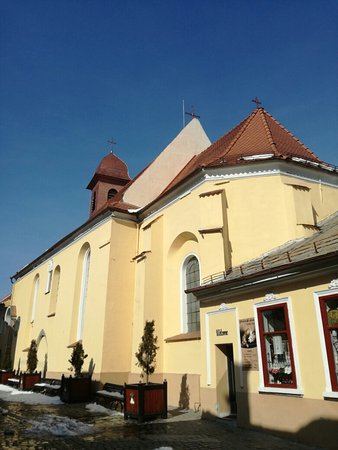The St John the Baptist Franciscan Church and Monastery is a complex of buildings with an L ground-plan and has the wooden bell-tower as its outstanding feature.
On the southern frontispiece of the nave there is a late Gothic walled-up archway from the 15th century above which stands a commemorative tablet from 1725 dedicated to the generous General Tige and his wife, bestowers of the church. A corridor leads to the western entrance of the church, but before the 1725 reconstruction on the north side there used to be another one with an adorned stone frame and a Renaissance bas-relief still visible today.
The interior features Baroque church furniture made in the late 1730s, with inlay so common in those days. The main altar dedicated to St John the Baptist is made up of three pieces. The central piece is an oil painting which represents St John baptising Jesus Christ in the River of Jordan with three Corinthian columns on each side. Above the altar there is a richly adorned gold medallion featuring the coat-of-arms of Ludwig Andreas Khevenhüller and his wife, patrons of the church, and a date (1729). On both sides of the interior arch stand the secondary altars dedicated to Virgin Mary and St John of Nepomuki copying the style of the central-piece. In place of the tabernacles the illustrations of the two patron saints of the order: St Francis of Assisi and St Antony of Padua are on display. The statues inside the Saint John Church dating from the turn of the 20th century illustrate the Stations of the Cross (1892), Our Lady of Lourdes (1890), Saint Anthony (1900), Saint Francis (1930), the Virgin Mary as well as Jesus Christ the Saviour.
The church organ was built in 1751, rebuilt in 1939.
In the 20th century, the St John the Baptist church underwent two major restoration repairs during which the artist, Hans Bulhardt, painted the interior in Neo-Baroque style and completed the fresco on the northern wall illustrating St Antony and the she-wolf. The second repairwork was performed following the 10thNovember 1940 earthquake which caused serious damage.
The church is listed as a historic monument by Romania’s Ministry of Culture and Religious Affairs.

